Some Context
I toured Amazon San Marcos (SAT2) back in the fall with some friends from this reading group who were curious to visit industrial spaces and perhaps develop better industrial literacy. I recently returned on my own for another look. You can also sign up for virtual tours here, though I’ve not done that (yet) for fear that it would alter my impressions of the physical experience before I’d committed key reflections to memory or to text. My goal here is to write strictly about my impressions of the facility. Of course, this is influenced by whatever prior knowledge and perceptions of the company that I have. To be clear, my general perspective is that rapid distribution of consumer goods is incredibly important and that Amazon seems to do this better than anyone before.
I went through this same process (two tours) with the Toyota Texas facility and hope to get notes down on that soon, as well as some sort of comparison of the two spaces. Why? They say that Ford’s production line was influenced by the disassembly lines of the meatpacking industry and that a Toyota delegation was inspired to operate a pull system by the lean inventory practices of Piggly Wiggly (a US grocery store). In this vein, I think observing commercial systems to draw analogies is a good design habit. System designs aside, it can be helpful to see standards of cleanliness, safety, signage, and communication. Lastly, I think industrial spaces can offer a window into institution’s ethos - of a sort that can be hard to fake / perhaps more legible than other approaches.
Tour Overview
The arc of the experience looked like this: sign up > arrival > entry > intro > 1st stop: “Stow” > 2nd: “Pick” > 3rd: “Pack” > 4th: ”SLAM” > 5th: “Ship” > Q&A > depart. My full notes (voice transcribed reactions after the tour, pulled into comprehensibility by Claude) can be found here, though it’s a bit lengthy. I’ll summarize each stage below.
The signup form online asks for logistical info (how many people, pick a time, etc) as well as perceptual info (perception of the company as a whole, as an employer, as a safe place to work). The feedback survey (emailed out afterwards) asks similar questions (presumably for comparison - everything about the space seemed quite data driven). I took this to imply clear priorities, namely, managing public opinion of the brand, especially as an employer. This is unsurprising given Amazon’s labor challenges, though it did seem to sell things a bit short (addressing a negative feels very different from championing a positive).
You could see other elements of this dynamic upon arrival. The parking lot looked like any other, with some ample safety signage.
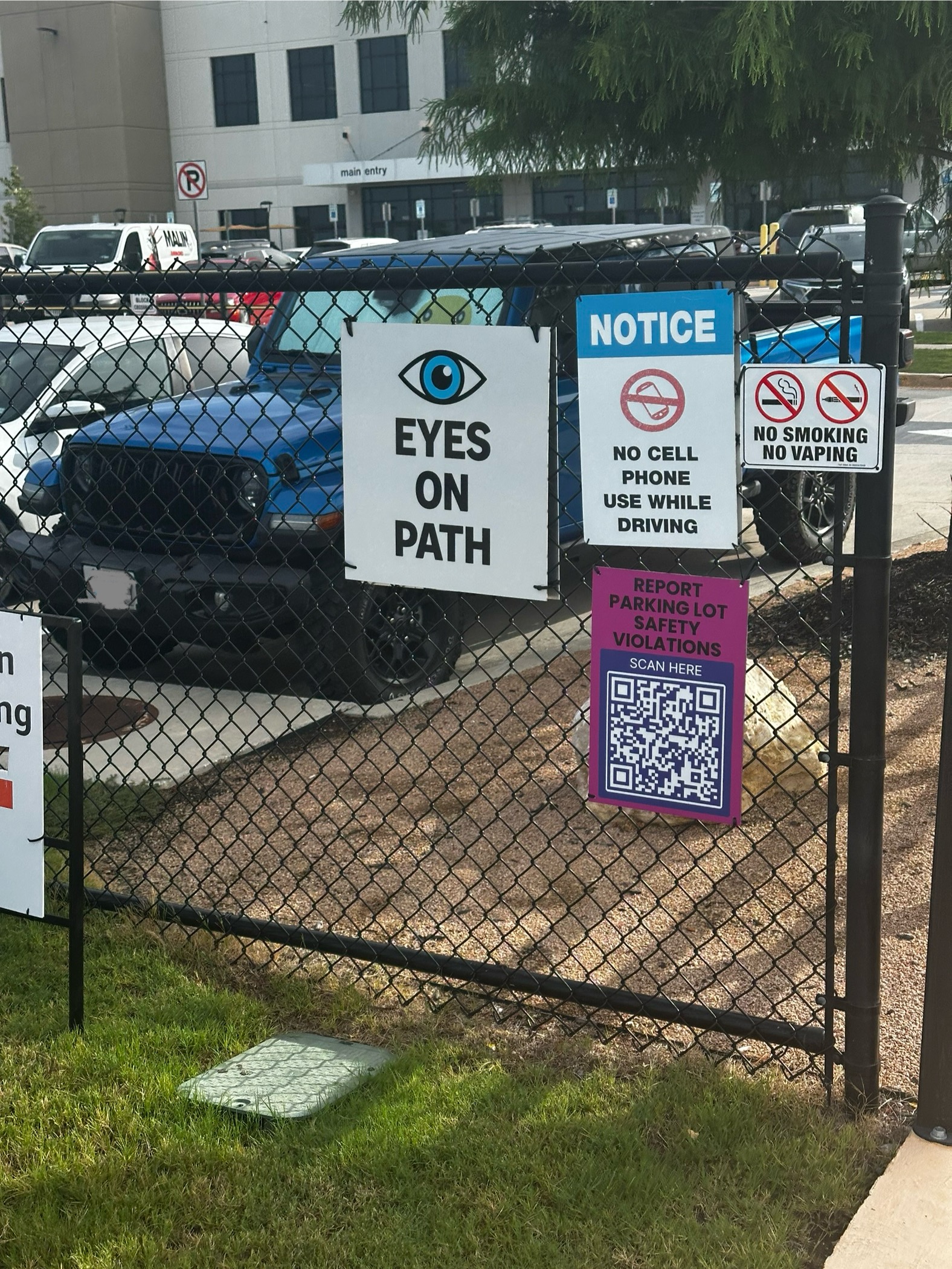
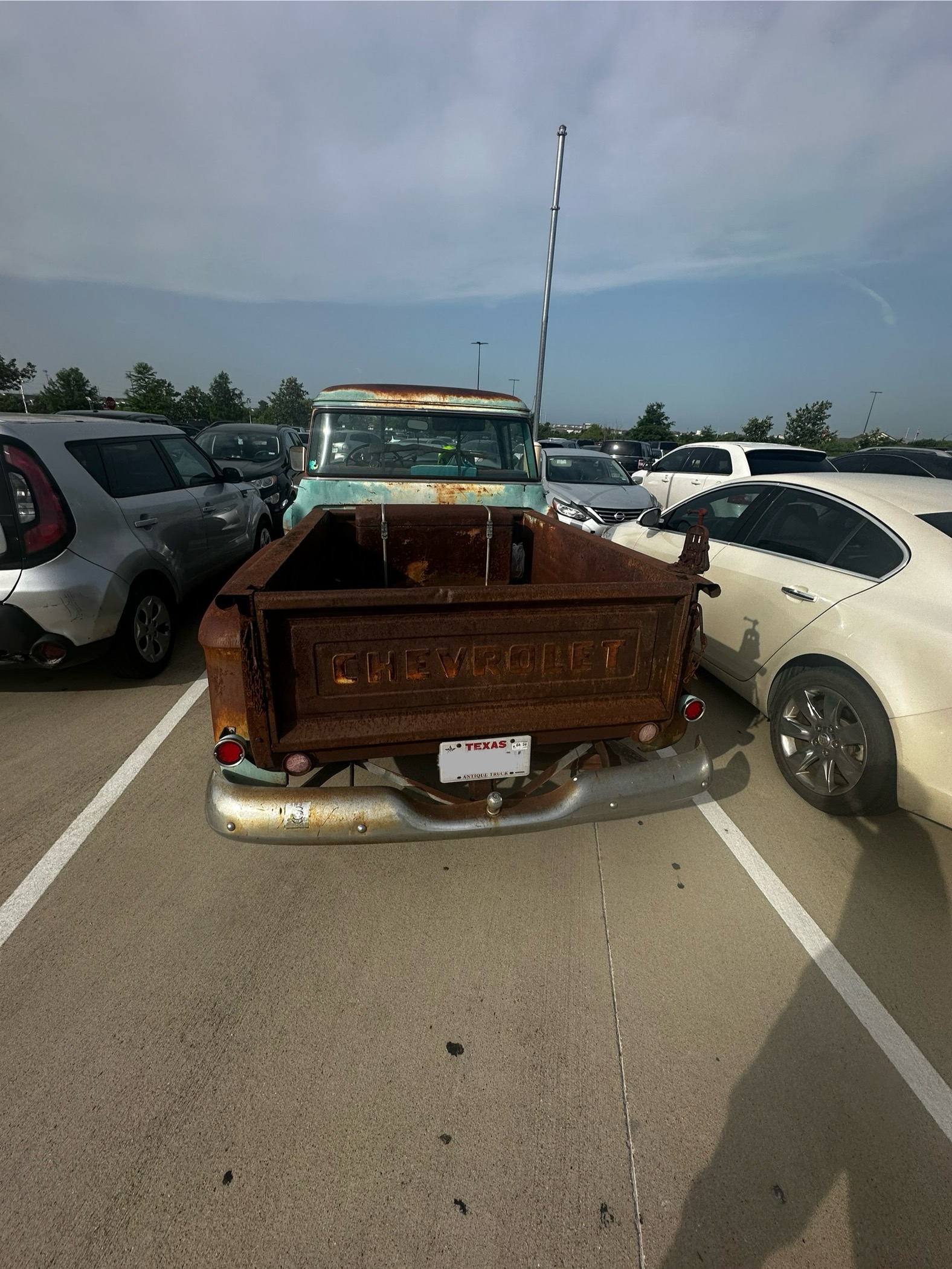
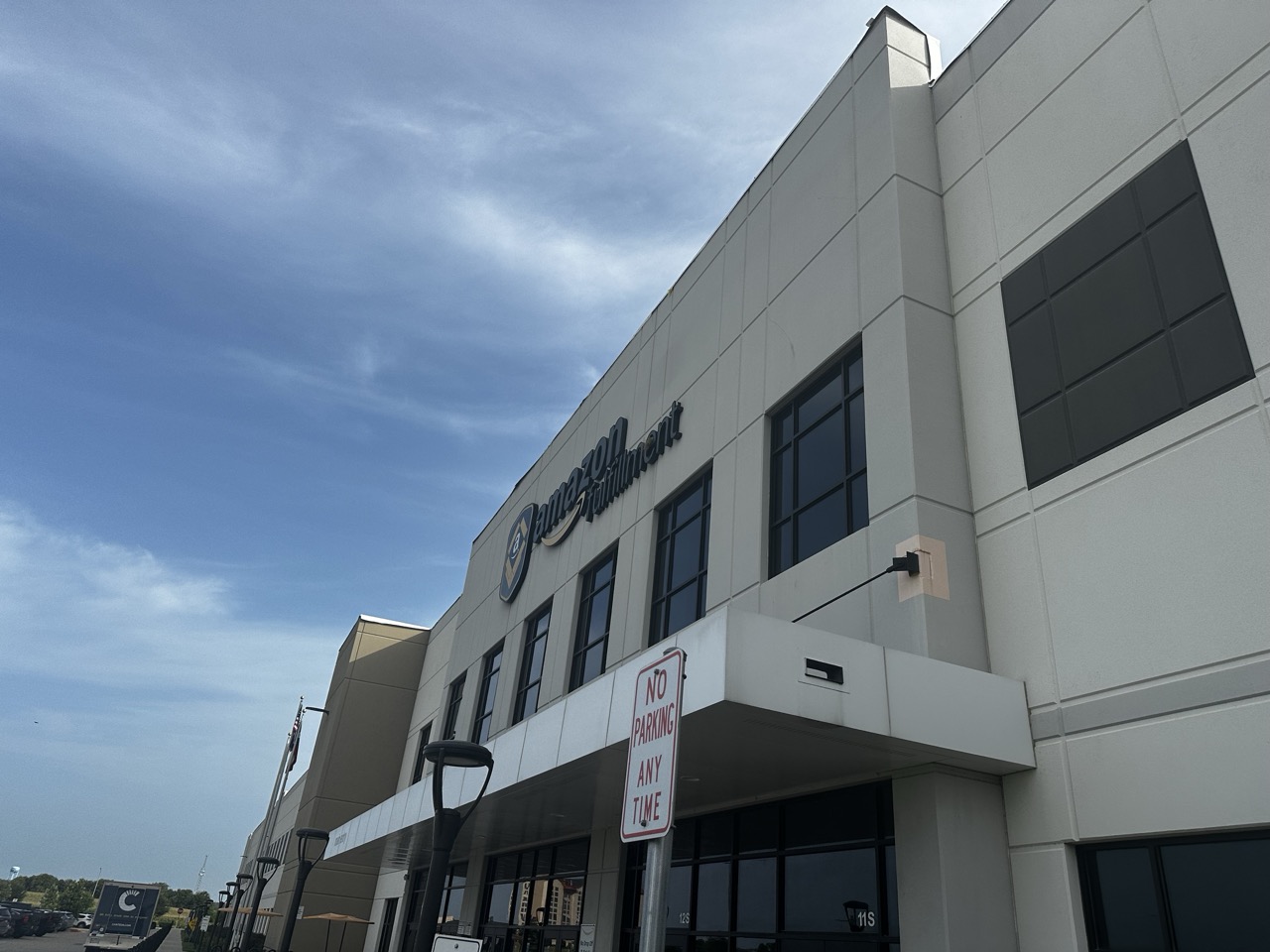
The entry area (not exactly a lobby, just a sort-of industrial foyer) was utilitarian (& maybe slightly squid-games-y?). It’s a wide and slightly shallow, perhaps 25x50ft square space, with some company signage on the wall and multiple doorways (like those rotating subway entry things). There was a security team on the other side, seemingly completing their morning huddle before going to their posts at various entryways, checking IDs and the like.
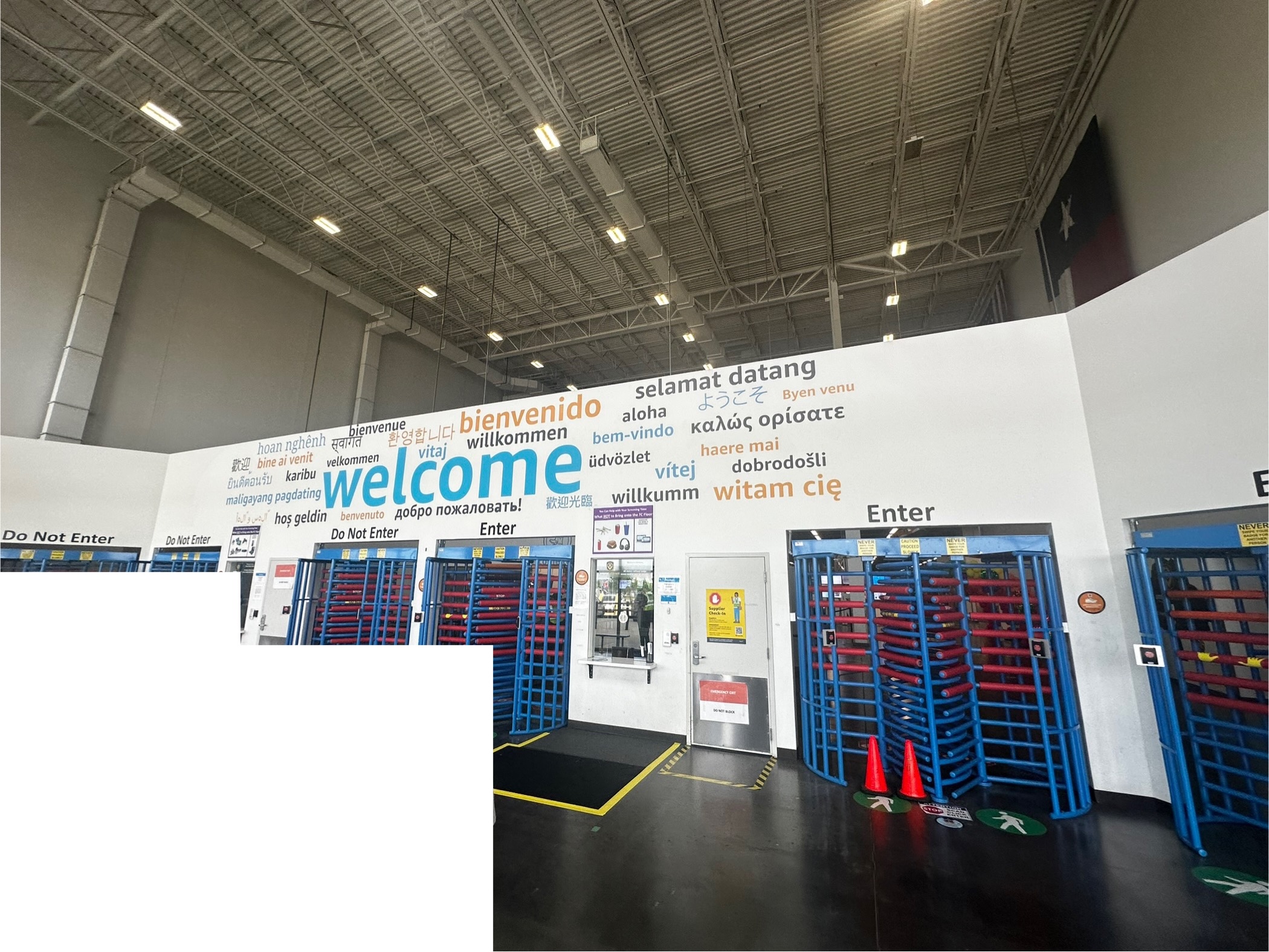
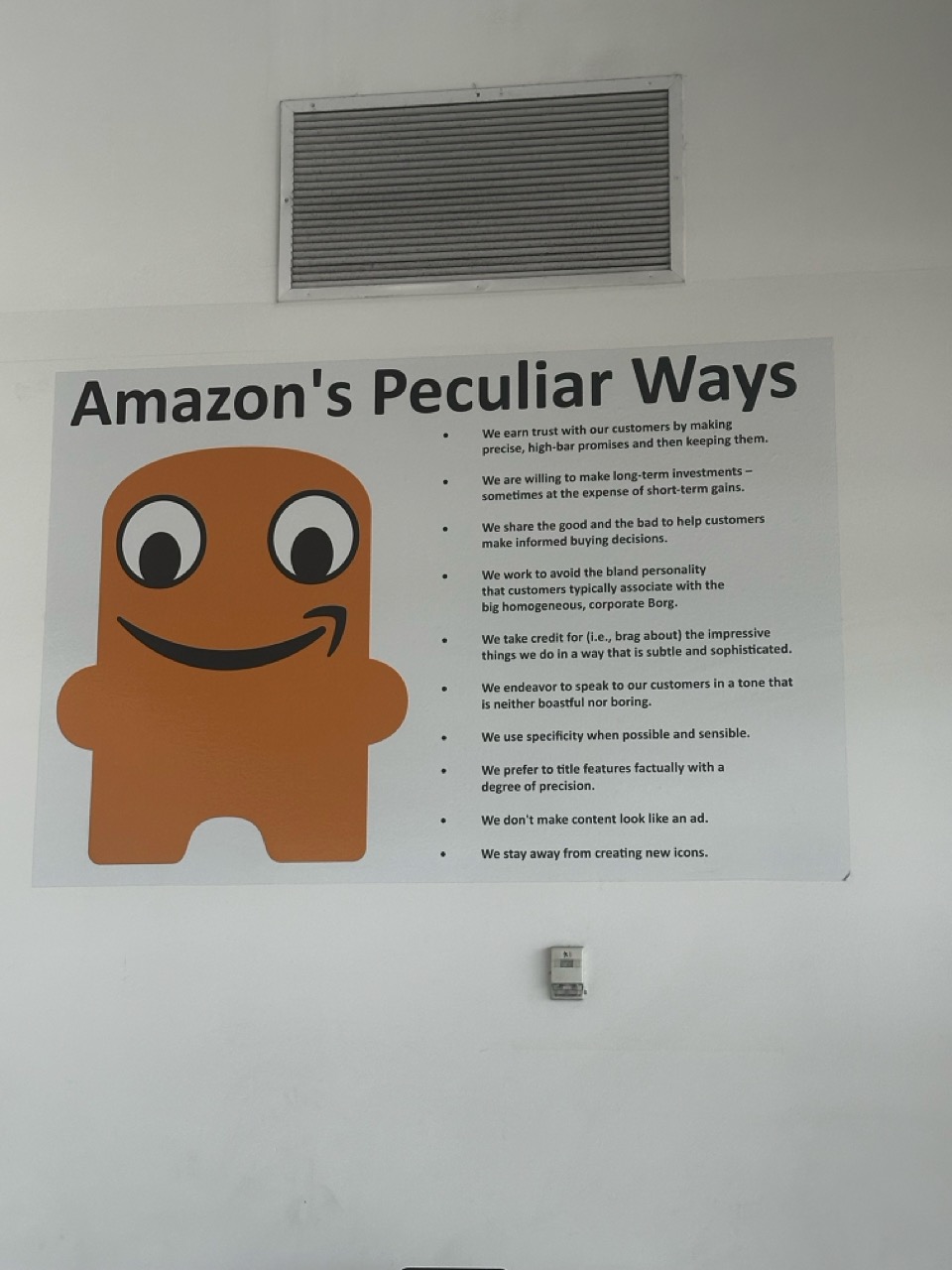
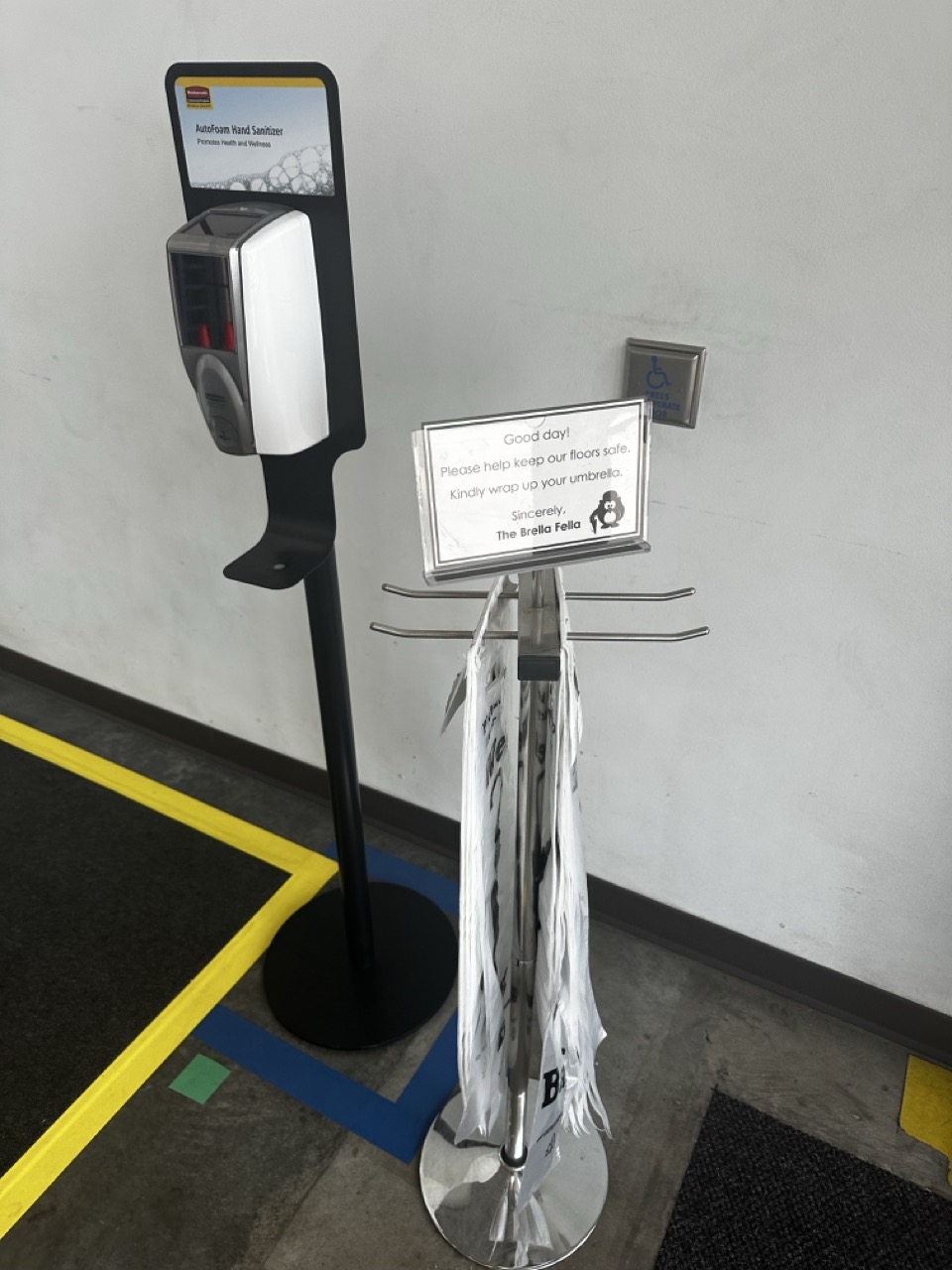
We met the tour guides in this lobby/foyer space and checked in. After passing through that entry area, we walked through a series of rainbow balloon-arches celebrating Pride month. These were part of a larger decorated area with desks and screens and signage providing information for employees. There was sort-of a lot going on - like it seemed like a sort-of major interaction point for HR - perhaps where some meetings or events were held - though nobody was there when we passed through. It had a sort-of ambient, transient feeling. In particular, I noticed a set of screens displaying comments from employees to HR / the company generally - apparently an effort at transparent exchange of feedback.
This space opened up into the rest of the facility, though we tucked into a door on the side for an orientation. Tour guides introduced themselves & spoke briefly about their backgrounds and time at Amazon. We also watched an introductory video that was informative and somewhat theatrical (the tone and informality were quite different from Toyota’s orientation video). We were also shown how to use headsets with microphones, which we relied on for the rest of the tour. From there, we walked out onto the floor, starting at “Stow.”

“Stow” and “Pick” are the inventory input and output points. The inventory is stored in a dynamic forest of yellow shelving towers (the size of a very larger person), and Kiva robots (large, heavy, Rooma-like bots that lift and transport the towers from beneath). The forest is fenced off from people, however. It’s only safe to enter if you wear a special vest (like this) which makes you ‘visible’ to the robots. Some of the robots were signed (apparently if you win a competition or something as an employee you get to sign a robot).
Apparently Amazon acquired Kiva for 750m$ in and there are over 10k robots in the facility - something like 4k per floor - they charge themselves when nearly depleted by navigating to a central point. They navigate via QR codes. Here’s an image of them carrying inventory pods on amazon’s website.
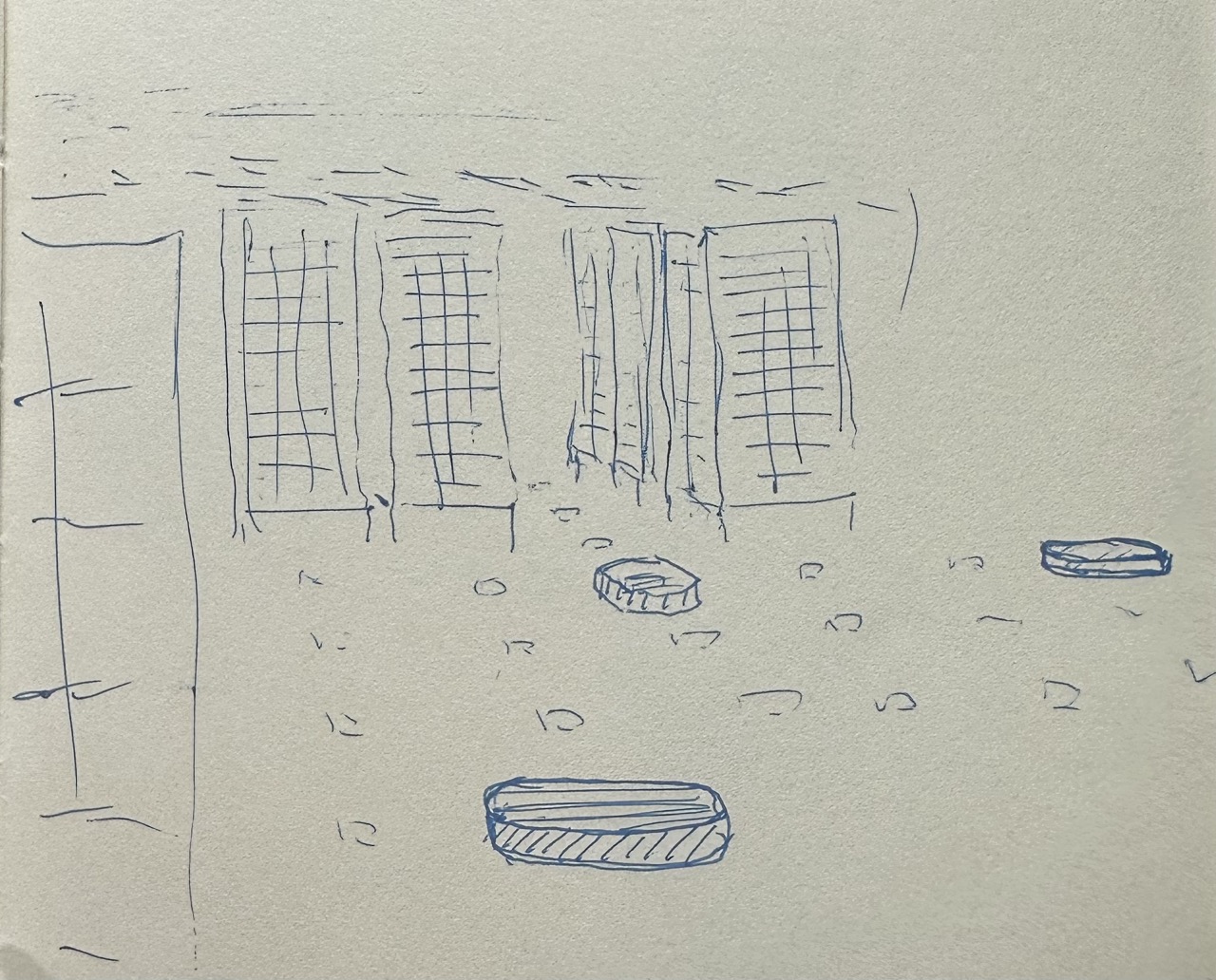
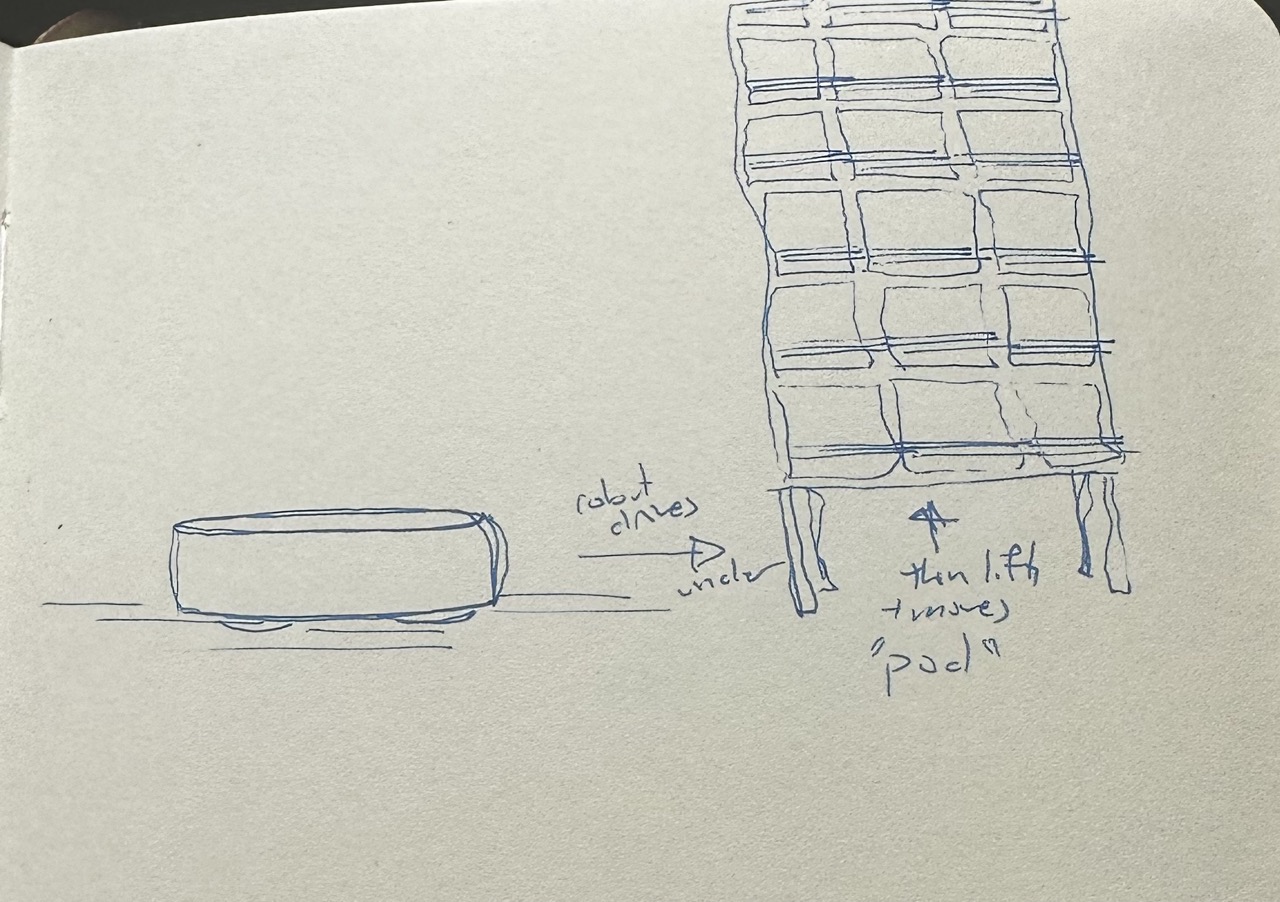
So, Stow and Pick are these ‘handoff’ points - gaps in the fence, where where robots deposit empty shelves for people to fill up (then whisk them away into the forest once full). The storage system has no ‘categories’ for stowage - it’s optimized around getting inventory in and out quickly, so each item goes wherever it can and is tracked individually. Here’s an image of a stow station on amazon’s website.
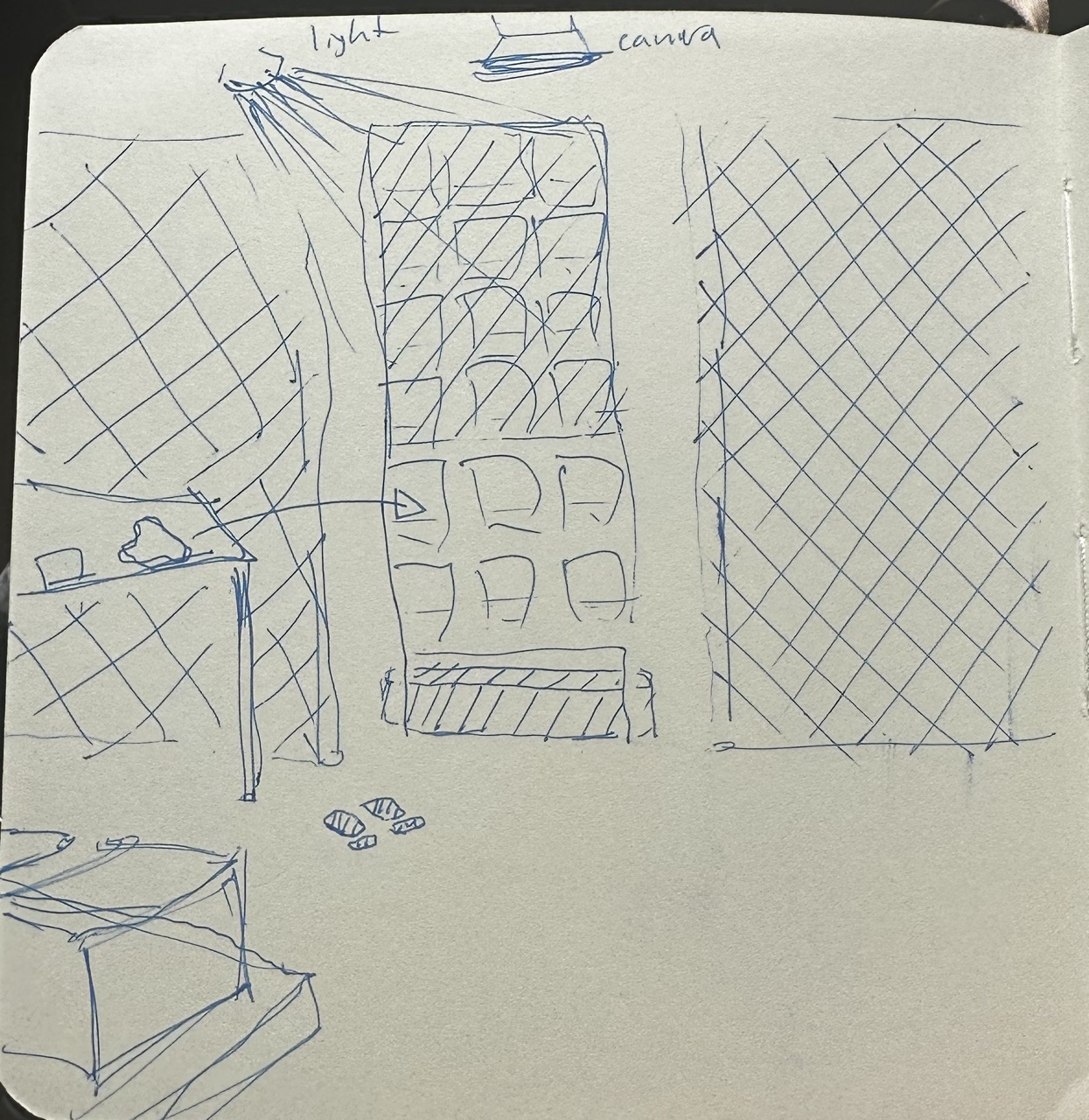
Given the variety of size & shape of goods, shelving cubbies vary in size. A lighting system highlights where an object can fit in the shelving and where it can’t (by projecting an overlay of colored light), and the stow-er places the item. A camera tracks which of the available cubbies it enters into (the stow-er needs make the product visible to the camera in the process), and tracks it’s location from there on out.
At this point, the product becomes available for customers to order. When somethings ordered, the robots bring the shelf containing the item to a “Pick” point. Here’s an image of a pick station A screen shows an employee the information about the good that needs to be picked (an image of the item). A set of totes wait to receive packages from the pick-er, with lights indicating which tote to drop the item into and when to push the tote onto the conveyer.
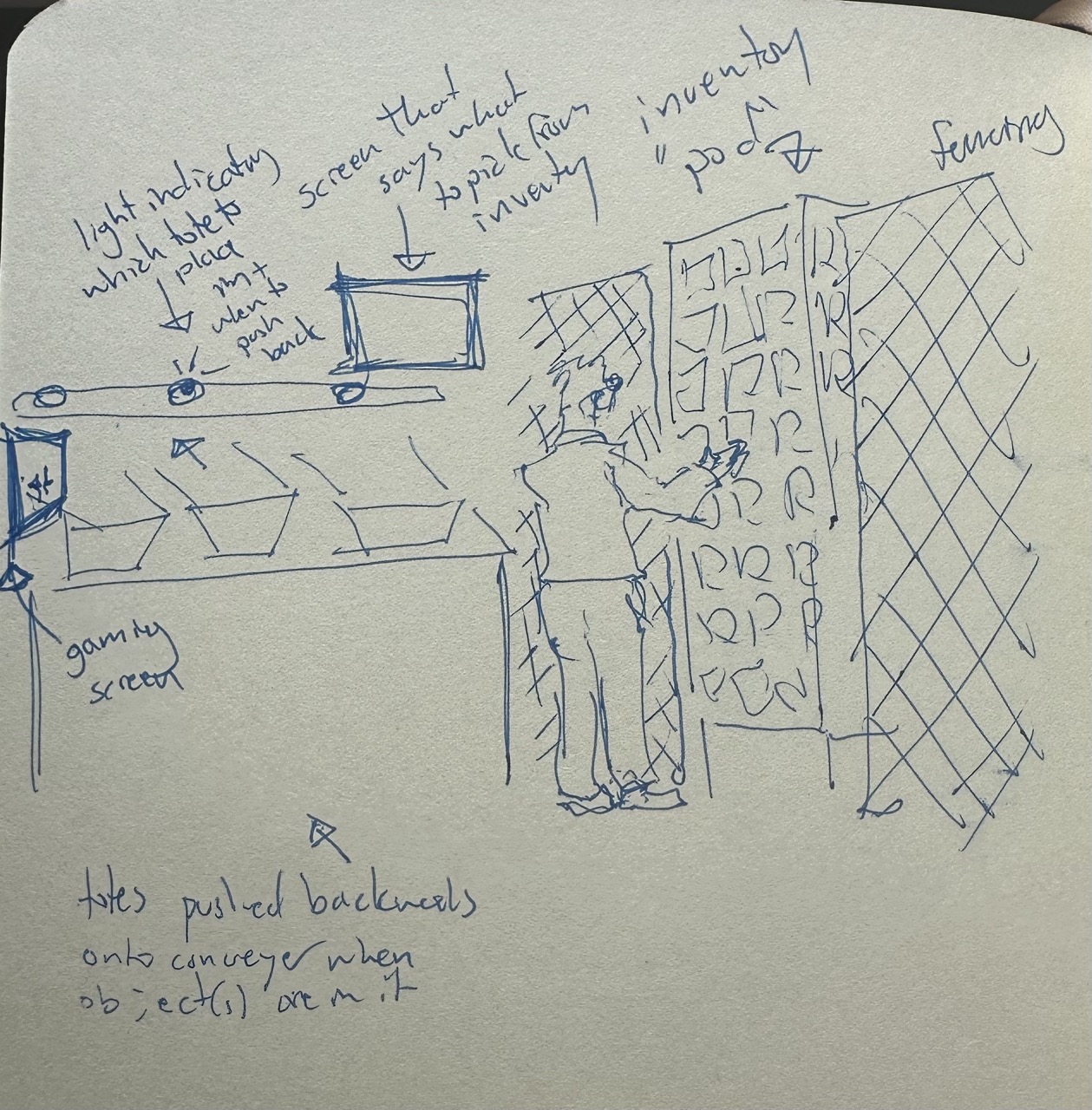
Picking is oddly & optionally gamified - there’s a screen where the pick-er can compete in a variety of games (farm-ville like I think) against others around the world (using speed and quality of their actual work in the game). This seemed like it might help the time pass more quickly, but definitely also felt pretty uncanny.
A system of overhead conveyance brought those items to a row of packing stations elsewhere in the facility, where folks packed and taped items into cardboard boxes (at stations like this), then set them back on a new conveyance track.

Right doodle: an individual packing station with boxes of various sizes at eye level and a workspace for packing (tape, spu printer), all with conveyance running alongside. The light above the station had 3 modes, but I don’t recall what they each did (I think something like ‘stopped’ ‘packing fine’ and ‘need something refilled’).
This system of conveyance (running from Pick > Pack > Slam > Ship) is all monitored from the ‘duck nest’—a set of screens and standing desks in the center of the facility (no walls, just a dedicated space). Screens showed camera feeds of common conveyance jam points, graphic representations of the flow throughout the system (green for flowing smoothly, yellow or red for issues), as well as quantitative dashboards with speed and quality metrics.
After the packing station, packages passed through the almost entirely automated “Slam” station, which, in the span of under a second, scans a barcode on the outgoing cardboard box, checks the weight matches the expectation, and drops a shipping label onto the box.
These labelled boxes then moved to a larger and faster moving conveyance system (conveyer like this) which allocated them to the correct ‘chute’ (like this) based on destination, which in turn slides the packages down one level to the correct loading dock (”ship”)
This was one of two points at which we were allowed to take out our phones - namely, to photograph a robot arm that was stacking totes onto pallets. It was the only robot arm in operation, it looked effective and expensive, though the moment felt a bit staged.

On the way back, we had our second photo opportunity, a mural (I believe painted by someone who works at the facility and does murals part-time). The mural was quite large - it ran the length of a hallway, perhaps 50 or 60 feet. These are a few scenes below.
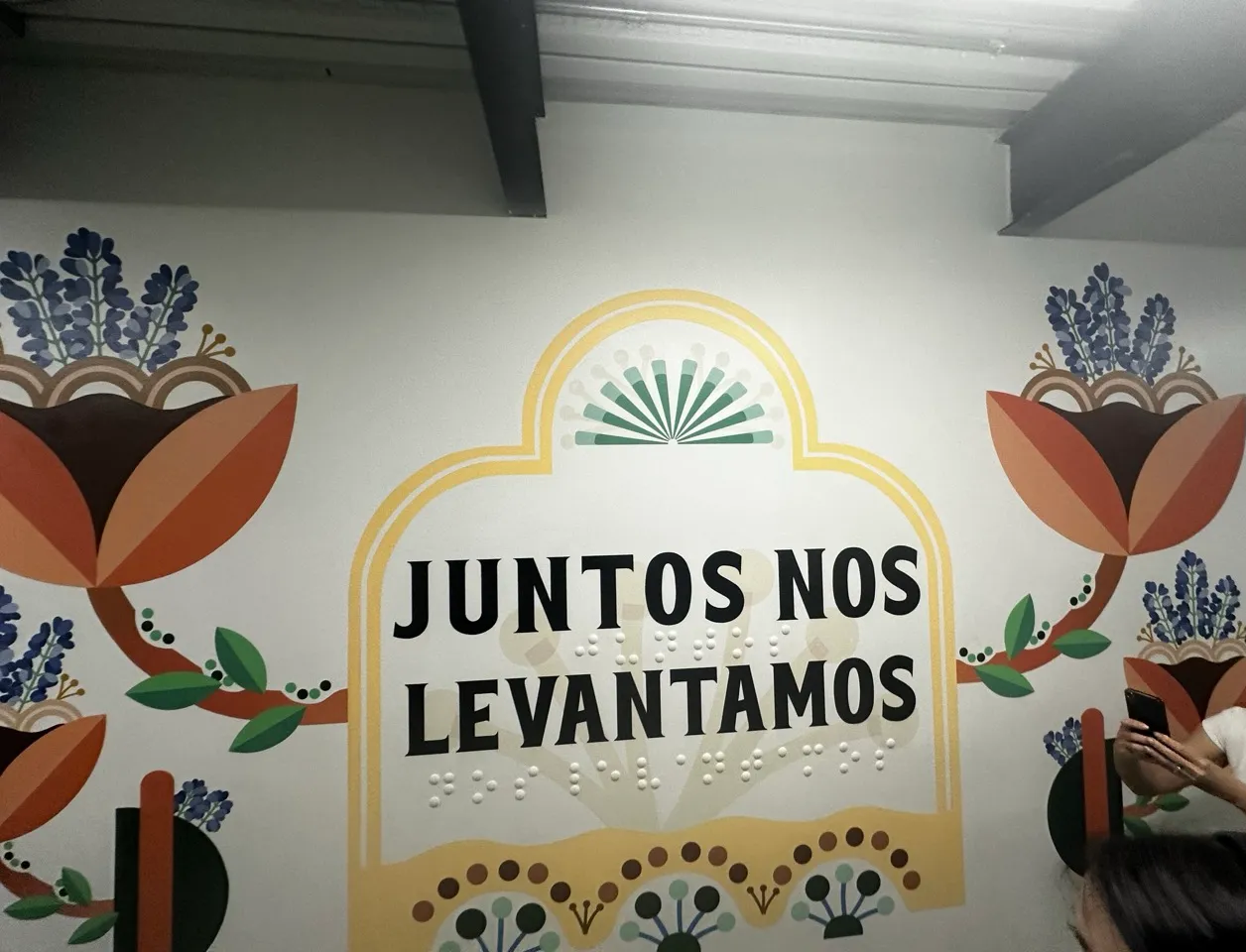
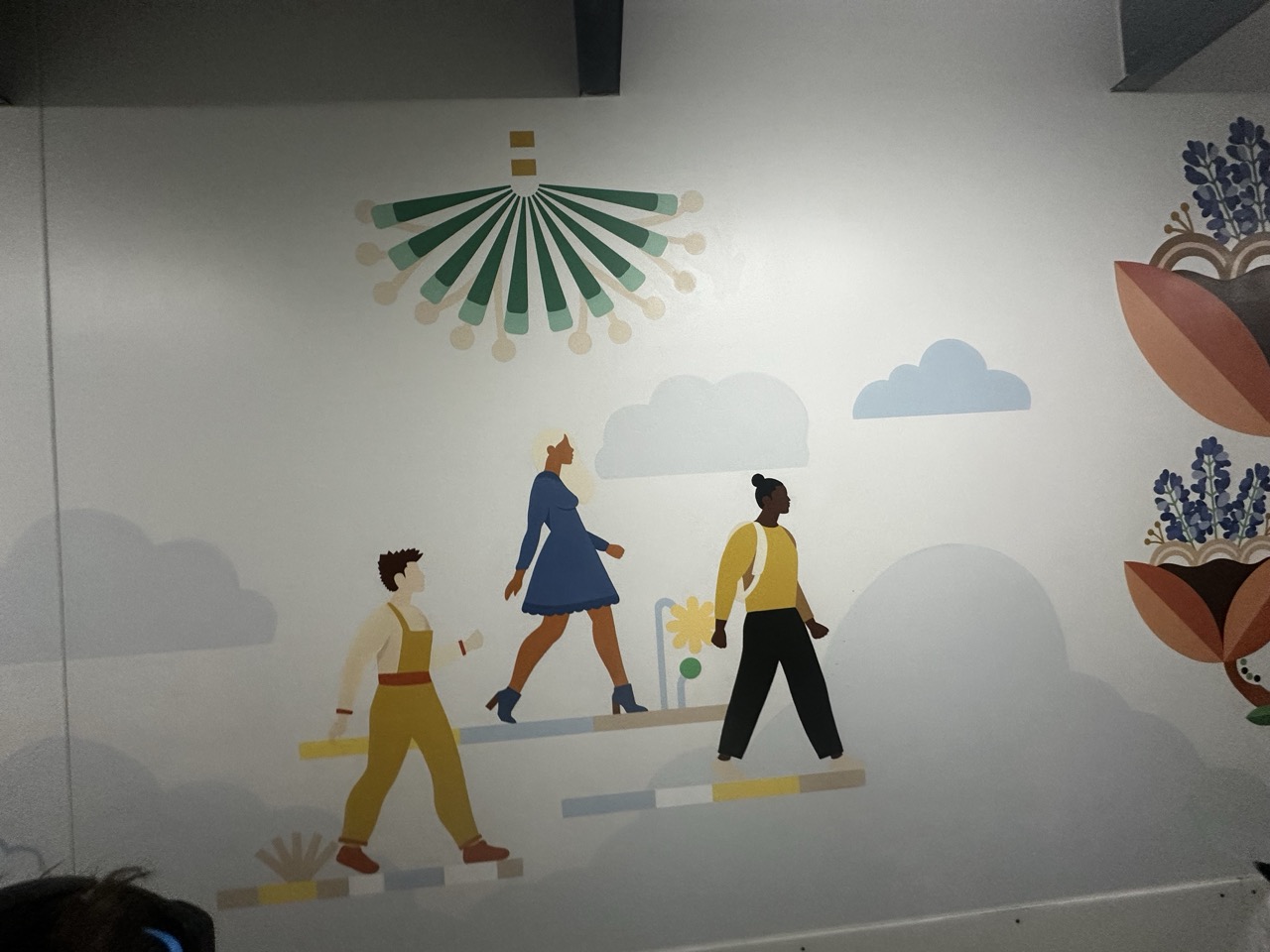
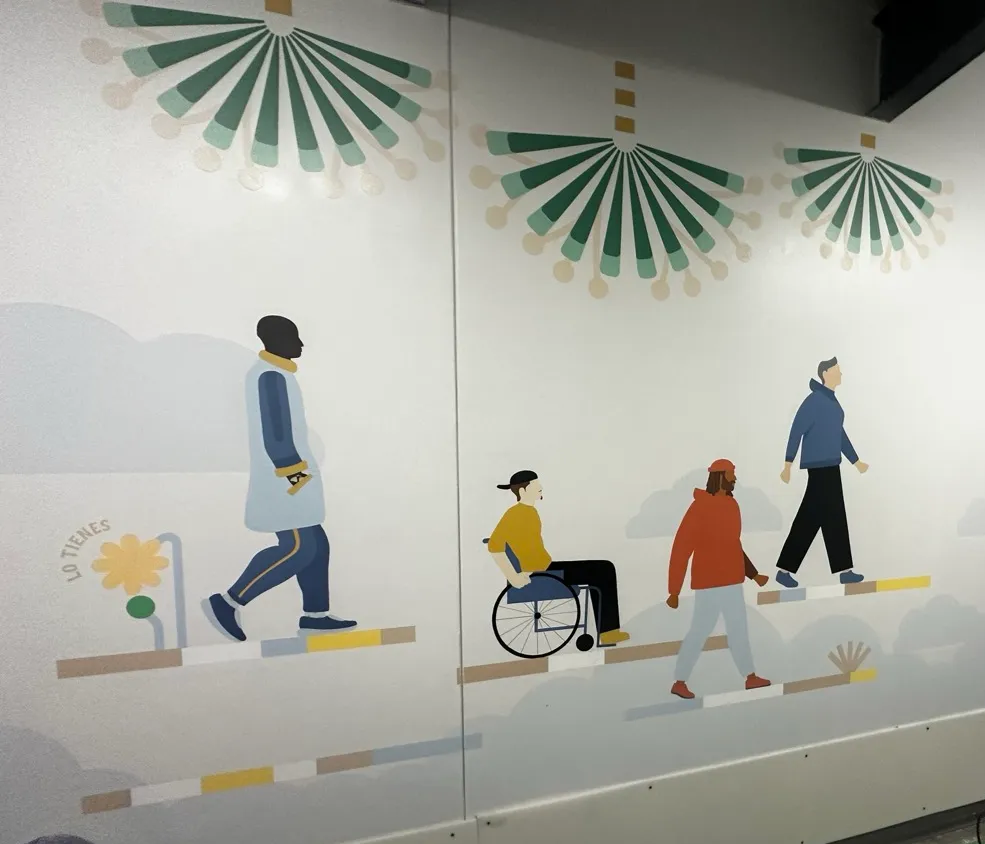
I think the robot & mural photo ops say a lot about what Amazon wants visitors to take away from the facility tour & share with the outside world - i.e. something like ‘we do automation’ and ‘we do uplifting inclusivity’ respectively. It definitely felt a bit forced to me (more than a bit), though the robot was cool and it was neat to see art in an industrial setting.
From there, we returned to the original orientation/meeting room and had some time for Q&A.
Other Info
Most workers are paid hourly while managers are salaried, and there are many flex and part-time workers beyond the 1,300 full-time employees (possible and necessary due to the facility’s constant operation & the frequent demand fluctuation - e.g. holidays, prime week, etc). The building opened in 2016, which apparently makes it "old" for an Amazon fulfillment center. You can feel some wear, but it's still functioning well. The tour guides emphasized with some pride that this less automated facility can still compete with newer, more recent and more heavily automated ones because the workers—many there for seven or eight years—really know what they're doing. On both tours I attended, when automation came up, tour guides noted that they (people) retained a key advantage over robots in the form of hand dexterity. I found it telling that folks were working with this particular frame of their comparative advantage over machines. There was a sense of ‘for now’.
Interestingly, as a test facility, they sometimes change something overnight—workers come in and a process has been modified. They run those tests for two weeks or a month, analyze the data, then either make the change permanent & bring it to other facilities, or revert back to the prior process. There's also an application for employee suggestions, and a safety committee reviewing change proposals.
Observations
I found that most of my other observations come in the form of potential ‘patterns’ (in the vein of A Pattern Language). In other words, here are some distinctive elements of the space and my reactions:
Vests
Vests were all over the place. There's an ecosystem of different roles, largely visible through the range of vest colors and labels: safety, security, process assistant, tour ambassadors, learning ambassadors, and a few mysterious "sat2 gather we rise" gray vests (perhaps trainees?). There's also an "amnesty vest" loaded with sensors so the robots can detect the wearer and avoid collisions—that person can navigate the robot floor to pick up dropped items.
Gatherings
During my first visit, I saw no gatherings or meetings. During this second visit, I did. Specifically, a security team’s morning meeting near the entrance (maybe six to eight people who looked pretty normal - not like super buff bouncers or anything), and a meeting of gray vests at "the duck nest"—the central monitoring station with standing desks and walls of screens showing the flow of materials throughout the facility.
Clear Bags
It looks like employees can bring stuff into the facility with them, but it needs to be in a clear bag (this is the impression I got from seeing several clear bags with water bottles and the like sitting at individual packing stations).
Air Control
The space seemed to be mainly cooled by these soft/inflatable overhead air-tubes and was tolerable, but warm. I can imagine it gets pretty hot in the peak of the summer.
Other patterns included: Color coding of all sorts, tape on the floor everywhere delineating standing and moving areas, holding areas, signage of myriad forms (safety, informational, directional), and ample overhead conveyance.
Smiles and Head Nods
I started trying to count how many times folks working in the facility smiled or nodded at the tour guides or the tour group. I didn’t come out with clear numbers, but it was definitely less at Amazon than at Toyota. To be fair, we were in a small vehicle at Toyota, so we likely passed more people, but my impression remained unambiguously that there was more pride & habitually more human-human acknowledgement in the space at Toyota (this may have also been partly a product / necessity of a more hazardous environment - you have to acknowledge awareness of other people in your area when vehicles and robots and parts are moving around constantly).
Piggly Wiggly
If my goal were to extract inspiration from Amazon's system for other application areas, a few points come to mind:
Light to delimit options: The use of lighting to queue human actions at stow and pick points was a really interesting interaction. Certainly any other picking or stowing task could be made less cognitively demanding with better visual queuing (I would love it if I could navigate a grocery store - or any shelved retail or commercial environment - in a more focused manner, perhaps with an AR overlay letting me search for particular areas. Similarly, I can imagine walking or biking or driving directions being overlaid on sight (some paths blocked out or highlighted). Lastly I could imagine dynamic safety signage in the form of lighting being used to direct people to stay away from operating machinery, or out of the path of a moving robot, or into a particular standing or walking area. If there are areas where it's high stakes to 'pick' the right thing (maybe a pharmacy? or pulling the right tool or drug from a medical kit in an urgent scenario?) then perhaps lighting queues could be used to create clarity there as well.
More dynamic inventory: We could also just imagine any current form of inventory shelf space being replaced by more dynamic and autonomous storage systems. Even without complete automation, you could have camera systems tracking inventory locations (removing the need for library-like categorization) and semi-autonomous tools to move inventory around (I'm thinking of Robust AI's tools here). I'm also thinking of how laundromats store clothes on a mechanical rollercoaster & can summon a given order with a button. I'm also thinking of how urban vehicle storage sometimes stacks and, again, summons specific cars mechanically, like a vending machine.
Visible metrics everywhere, open duck's nest: there was something really appealing about an open-floor plan central monitoring station- it definitely conveyed a different tone than, say, an office with monitors overlooking the floor. More broadly, having individaul, team, and facility metrics visible all over the place (I'm actually not sure what was visible to a given Amazon team member - realtime dashboards were all over the place in the Toyota facility) seems like a generally sensible practice.
Otherwise, I'm not sure. There were a lot of little, simple designs and automations to catch errors or to set packages up correctly for subsequent processes. Perhaps focusing more granularly on those, combined with picking a clear problem space to/in which to translate/apply learnings would help. There's certainly more here.
Concluding Thoughts
The setup was incredibly technically impressive (both in the sense of the components / stages and the overall system) and I’d love to spend more time there if I could. It doesn’t feel like a place I’d be thrilled to work as an hourly employee for a long time (contra Toyota, which conveyed a particular sense of pride, authentic or engineered), though it does seem like the schedule flexibility and some of the education funding could be appealing in another context.
In general, the space felt surprisingly transient or liminal and the interactions seemed isolating. I don’t mean that as a critique of how the facility is set up or as a moral or cultural critique - instead, I suspect it’s largely a downside of distribution vs manufacturing. On the Toyota line, there was much more visible / tangible inter-reliance between people. You could (in most cases) see the team on the line before and after you - if they didn’t show up, or their work wasn’t done by the time the vehicle shifted to you, it’s a major problem.
The distribution facility, in contrast, was generally characterized by a lot of machine-machine interactions. Sure, you were handing the package to another employee via the conveyer, but it’s not like you could see them.
Interestingly, Toyota’s continuous improvement team received line improvement recommendations via a physical piece of paper (a form), while Amazon had an app for employee suggestions.
Toyota also did not have flexibility in shifts - everyone worked the AM and the PM shift on a regular rotation (every few weeks) etc etc, so I imagine folks are bit more ‘in it together’. The product of all that effort is a new vehicle, which looks awesome and sparkles and honks as it comes of the line. Of course, it could be that this is actually just a successful cultural project of Toyota + American manufacturing culture, and that Amazon hasn’t figured this out in the same way.
On the whole, I’m the Amazon facility seems so well optimized & to have a tempo and expectation of continual development that I’m abundantly confident they’ll continue to offer incredible goods and services. If you are reading this and work at Amazon (or in distribution generally) and are able to talk about system design or culture to some degree, then I would love to ask you about it.